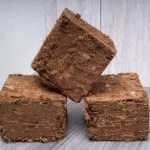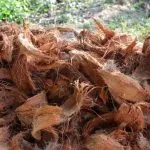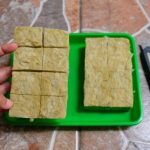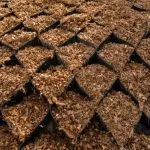Choosing the right growing medium is an essential step in the hydroponic growing process. When it comes to coco coir vs rockwool hydroponics, there’s a lot to consider, as both materials have unique properties that can influence plant growth. In this article, we’ll dive into the key differences and benefits of these two popular hydroponic growing media, helping you make the right choice for your plants and system.

Coco coir, derived from coconut husks, is sustainable and versatile. This natural, renewable resource provides excellent water retention and aeration, making it suitable for a wide variety of plants. Additionally, coco coir has hormone-rich and almost fungus-free properties, ensuring an ideal environment for your hydroponic plants to thrive.
Rockwool, on the other hand, is a water-absorbent material made from melted basalt rocks, offering a consistent and inert growing medium. This makes it particularly well-suited for hydroponic systems where plants require a steady moisture supply. However, it’s essential to keep in mind the environmental impact of Rockwool, as its production process is more resource-intensive compared to coco coir.
Coco Coir as a Growing Medium
Coco coir is made from coconut husk fibers. It’s a beneficial byproduct of the coconut industry and comes in different types, like coco peat and coco chips. The former is excellent for water retention, while the latter provides superior aeration and drainage, catering to your plants’ specific needs. The brick form is easy to buy in bulk and easy to store and transport.
The eco-friendly coco coir is organic, renewable, and created without harmful chemicals, making it safe for your plants and the environment. Post-use, it can be composted, contributing to your green initiatives. Always opt for high-quality, well-treated coco coir to prevent any harmful contaminants from entering your system.
If you choose to go with coco coir as your growing medium, we have the perfect guide for a coco coir hydroponic setup.
Rockwool as a Growing Medium
Rockwool, a mineral wool derived from volcanic rock, is a great choice for hydroponic systems. It’s processed into an inert, insulating material ideal for plant growth.
Benefits include its non-organic nature, keeping it free from diseases and pests, and providing a sterile environment for plants. It maintains the perfect air-to-water ratio, ensuring adequate oxygen and water for plant health. It won’t react with nutrients in your solutions, fostering a balanced plant environment.
Rockwool can hold substantial amounts of water, aiding your plants’ root system and nutrient absorption, and it helps maintain stable root temperatures, minimizing heat stress.
Bear in mind that Rockwool originates from non-renewable sources like basalt, which may not be the greenest option. However, if optimal growing conditions are your focus, the pros could surpass this concern.
If you choose to go with Rockwool as your growing medium, we have a guide on using Rockwool for hydroponics.
Comparative Analysis: Coco Coir Vs Rockwool
In your search for the best growing medium for your hydroponic garden, you might be curious about the differences between coco coir and Rockwool. Here’s a simple comparison of these two popular hydroponic mediums to help you make an informed decision.
Coco Coir
- Weight: Coco coir is generally lighter than Rockwool, which can be an advantage for gardeners who need to move or transport their grow medium often.
- Cost: Generally, coco coir is less expensive than Rockwool, making it a more budget-friendly option.
- Sustainability: Coco coir, made from coconut husks, is a renewable and environmentally friendly resource, which might appeal to eco-conscious gardeners.
- Availability: Coco coir is widely available and can be found in most gardening or hydroponic stores.
- pH Level: Coco coir has a nearly neutral pH level, making it suitable for growing a wide variety of plants.
- Drainage: Coco coir offers excellent drainage, making it a good choice for plants that prefer drier conditions.
- Product Safety: Coco coir, a uniform growing medium, is derived from processed coconut husks. This process eliminates harmful salts and pathogens, making it suitable for hydroponic cultivation.
Rockwool
- Weight: Rockwool is typically heavier than coco coir, which may be a consideration if you need to move your grow medium frequently.
- Cost: Rockwool is generally more expensive than coco coir, although prices can vary depending on the form and quantity purchased.
- Sustainability: Rockwool is made from molten rock and may not be as environmentally friendly as coco coir due to the production process.
- Availability: Rockwool is also widely available, and you can find it in most gardening or hydroponic stores.
- pH Level: Rockwool may require adjustment of its pH level to suit your plants’ needs. However, once adjusted, it maintains a consistent pH level.
- Water retention: Rockwool tends to retain water longer than coco coir, making it more suitable for hydroponic systems and plants that require a steady moisture supply.
- Product Safety: It’s essential to wear proper protective gear, such as gloves and a mask, when handling Rockwool to avoid irritation from the fibers.
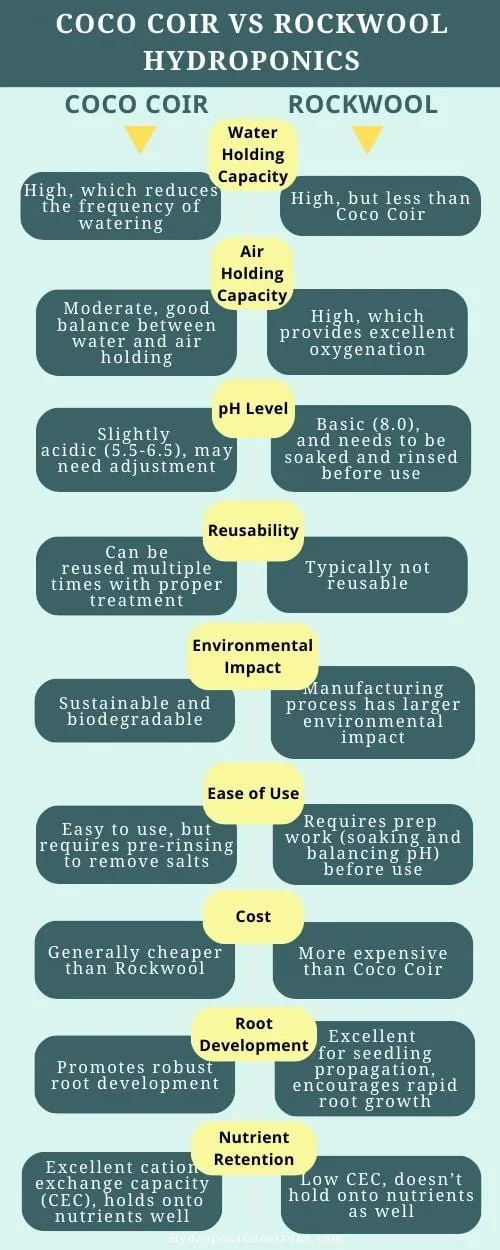
By considering these factors, you can make the best decision for your hydroponic garden, whether you prefer the eco-friendly option of coco coir or the water-retaining properties of Rockwool.
Properties Affecting Growing in Rockwool Vs Coco Coir
When choosing between coco coir and Rockwool for hydroponics, it’s essential to consider various properties of these growing mediums, such as pH levels, water retention, aeration, drainage, and environmental impact.
Coco Coir:
Your plants will benefit from coco coir’s naturally slightly acidic pH (between 5.8 and 6.5), which is within the ideal range for plant growth in hydroponics. This material is made from ground coconut husks and is becoming increasingly popular among hydroponic gardeners. Keep in mind that you’ll need to closely monitor and adjust the pH accordingly since it can vary.
Coco coir’s water-retention capacity is quite moderate: it can hold water without getting waterlogged, ensuring proper drainage, and providing sufficient oxygen to your plants’ roots. Its aeration properties are also impressive, as it helps prevent root rot and promotes healthy root growth. Coco coir is a sustainable, environment-friendly choice and breaks down easily in the environment.
Rockwool:
Rockwool, on the other hand, is more water-absorbent than coco coir, making it a suitable choice for plants that require a consistent moisture supply. However, its pH levels are typically higher than the ideal range for hydroponics, so you’ll need to adjust your nutrient solution’s pH to 6.0 – 6.5 for optimal plant growth.
Drainage in Rockwool can be less effective compared to coco coir, which might lead to overwatering issues if you don’t manage it correctly. Rockwool also provides good aeration and oxygen delivery to your plants’ roots, fostering healthy growth.
Mineral Content in Coco Coir and Rockwool
When it comes to mineral content of coco coir and Rockwool, it’s essential to understand their characteristics to make an informed choice for your hydroponic system.
Coco Coir:
Coco coir, a natural product derived from coconut husks, contains varying amounts of potassium, calcium, magnesium, and iron. Potassium is generally higher in coco coir as compared to Rockwool. As a natural product, the exact mineral content may vary depending on its production source. Due to its organic nature, coco coir has a high cation exchange capacity (CEC), which means it can absorb and release nutrient and pH-buffering elements more effectively, making it beneficial in hydroponics systems. This means that there may be a slight benefit in terms of coco vs. rockwool yield because of the increased uptake of K and S, as cited in this Frontiers article.
However, excess potassium and other minerals in coco coir can sometimes interfere with nutrient uptake, as they may compete with other essential nutrients for absorption. Therefore, it’s crucial to monitor and manage the nutrient solution when using coco coir to ensure optimal plant growth.
Rockwool:
Rockwool, on the other hand, is a man-made product created by spinning molten basaltic rock into fibers. It has a neutral pH and contains trace amounts of minerals with almost no significant presence of iron, calcium, magnesium, or potassium. Due to its inert composition, rockwool does not have a CEC value, so it does not exchange nutrients or buffer pH levels.
This difference means that, when using Rockwool, you have greater control over the nutrients and pH levels in your hydroponic system, as it does not interfere with nutrient uptake or cause imbalances. However, it also entails regular monitoring and adjusting of your nutrient solution to ensure your plants receive sufficient amounts of essential elements.
In summary, coco coir and Rockwool differ significantly in their mineral content and buffering capacities. With coco coir, you benefit from its high CEC and pH buffering but may need to manage its higher mineral content. In contrast, Rockwool offers more control over nutrients and pH but lacks the natural buffering properties of coco coir. Choose the medium that best aligns with your hydroponic system’s needs and your own management preferences.
Related: Learn more about coco coir nutrient content here.
Usage With Various Plants and Vegetables
When it comes to using coco coir and Rockwool for hydroponics, it’s essential to consider their suitability for various plants, vegetables, herbs, flowers, seeds, and clones.
Coco coir:
Coco coir, with its excellent water retention and drainage properties, proves to be a versatile growing medium for a wide range of plants. If you’re growing vegetables, especially those that prefer drier conditions, coco coir can be your go-to medium. Vegetables like tomatoes, cucumbers, peppers, and spinach, and herbs such as mint, cilantro, and basil will appreciate the well-draining nature of coco coir, allowing for proper oxygenation around their roots.
For clones, the hormone-rich nature of coco coir helps encourage root development and growth in a new plant, making it an excellent choice for propagating plants.
Rockwool:
On the other hand, Rockwool is highly absorbent, providing a continuous supply of moisture for your plants. This property makes it ideal for most hydroponic systems. If you plan to grow leafy greens such as lettuce or spinach, Rockwool can facilitate the constant moisture levels needed for these plants to flourish.
Flower enthusiasts might find Rockwool to be a good choice for growing water-loving flowers like hydrangeas and lilies. Rockwool enables these plants to receive enough water while also maintaining the needed oxygen supply to the plant’s roots.
When starting seeds, Rockwool is a popular medium because of its sterile nature. This quality helps reduce the risk of fungal diseases or pests that may affect your seedlings as they grow.
Environmental Impact and Sustainability
When considering hydroponic growing media, it’s important to weigh the environmental impact and sustainability of your choices. In the case of coco coir and rockwool, there are some key differences you should be aware of.
Coco coir:
Coco coir is an eco-friendly option, as it’s a byproduct of the coconut industry. Made from the husks of coconuts, this renewable resource has a lower environmental impact and contributes to sustainable living. Coco coir is also biodegradable, meaning it can break down in the environment and won’t contribute to landfill waste. This makes it a fantastic option for reducing your ecological footprint. It’s worth noting that coco coir can be reused several times before it breaks down, so you can also minimize waste by recycling it in your garden.
Rockwool:
On the other hand, Rockwool is made from non-renewable resources, specifically basalt rock and chalk, which are melted and spun into fibers. The process of producing Rockwool requires high amounts of energy and can be quite resource-intensive. This makes it less sustainable compared to coco coir. Furthermore, disposing of rockwool can be problematic, as it isn’t easily biodegradable and may take a long time to break down in a landfill. Some Rockwool can be recycled, but it’s generally not as common or simple as reusing coco coir.
To sum things up, use this information to make an informed decision about your hydroponic growing media. By choosing a sustainable option like coco coir, you’ll not only have a positive impact on the environment but also foster a greener, more sustainable way of living.
Alternatives to Coconut Coir and Rockwool
If you’re exploring hydroponic growing media options and want to consider alternatives to coco coir and Rockwool, we’ve got you covered. Here’s a short rundown of some other options for you to consider:
Peat Moss: As a natural and organic material, peat moss is often used as a soil amendment. It retains moisture well, improving the water-holding capacity of your growing medium. However, keep in mind that peat moss is a nonrenewable resource, and its harvesting can be environmentally damaging.
Perlite and Vermiculite: Both perlite and vermiculite are good alternatives for hydroponic systems. Perlite is a lightweight, porous volcanic rock that promotes drainage and aeration, while vermiculite is a mineral compound often used for seed germination and moisture control. They can be combined in the desired ratio to create a well-balanced growing environment for your plants.
Rice Hulls: As a byproduct of rice processing, rice hulls are an eco-friendly option for a growing medium. Their natural silica content helps to improve drainage and aeration, and they’re known for being affordable compared to other media options.
Sand: Although it’s not a common choice for hydroponic systems, sand can be used as a growing medium as long as it’s well-washed and free of contaminants. It provides good drainage and air circulation but can be heavier than other media, so keep that in mind when setting up your system.
Expanded Clay: Also known as clay pebbles or pellets, expanded clay is a hydroponic media made from heated clay that expands and forms a porous structure. This lightweight medium has excellent drainage and aeration properties, making it a popular choice among hydroponic growers.
Whatever option you choose, make sure to evaluate its availability, cost, and environmental impact, so you can select a growing medium that suits your needs and aligns with your values. Happy growing!
Practical Guides: Using and Reusing Coco Coir and Rockwool
Both coconut coir’s and Rockwool’s reusability is a fantastic feature, which helps reduce waste and saves you money in the long run. Each has its advantages, and both can be reused if properly handled.
Coco Coir
To start using coco coir, you’ll first need to get it in either bale or brick form. Shipping coco coir in these compressed forms saves space and is more cost-effective.
Before using your coco coir, you’ll have to hydrate it. Soak your bricks or bale in water until they expand to your desired consistency. Drain any excess water, and your coco coir is ready for seed starting. Make sure to monitor moisture levels throughout the growth process, as coco coir can become too dry or saturated.
To reuse coco coir, you must remove old roots and debris from the previous crop and then sterilize it. Be gentle during this process so you don’t damage the coir’s fibers. Once clean, you can reuse your coco coir.
Rockwool
Rockwool is a popular synthetic growing medium for hydroponics. Begin by acquiring appropriate-sized Rockwool cubes for seed starting or transplanting. Before use, pre-soak the Rockwool in water with a pH between 5.5 and 6.5. This helps create a hospitable environment for the seeds.
To reuse Rockwool, remove the old crop and gently scrape away any leftover root material. Be cautious during this step, as rough handling can damage the Rockwool’s structure. After cleaning, re-soak the Rockwool and adjust the pH as mentioned earlier. It is now ready for transplanting or seed starting.

